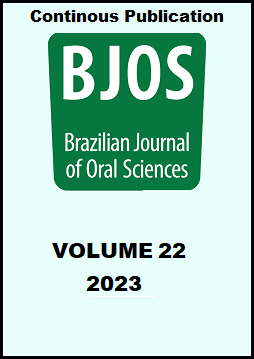Abstract
Aim: Bimaxillary protrusion is a common condition observed irrespective of race and ethnicity and is a chief concern for patients who seek orthodontic treatment. The aim of this study was to compare and evaluate changes in soft tissue structures and incisor positions in class I bimaxillary protrusion subjects undergoing orthodontic therapy when friction and frictionless mechanics were used. Methods: Two groups with a total of 40 patients aged 18–30 years diagnosed with class I bimaxillary protrusion treated by extracting first premolars were considered for this study. Patients treated with friction mechanics were included in Group 1 and those treated with frictionless mechanics in Group 2. The digital lateral cephalograms were calibrated and analyzed using Nemoceph software. Selected landmarks were marked on pre- and post-treatment cephalograms and assessed for intra- and inter-group soft tissue and incisor position changes. Student’s t-test was used to analyze the collected data using SPSS 20 software. Result: Intragroup comparison revealed significant changes in both groups. Inter-group comparison of the selected parameters between groups 1 and 2 showed differences but without any statistical significance, except for the inter-incisal angle. Conclusion: Pre- and post-treatment comparison analysis revealed significant soft tissue changes in both groups. However, the comparison between friction and frictionless mechanics showed no statistically significant changes.
References
Keating PJ. Bimaxillary protrusion in the Caucasian: a cephalometric study of the morphological features. Br J Orthod. 1985 Oct;12(4):193-201. doi: 10.1179/bjo.12.4.193.
Bills DA, Handelman CS, BeGole EA. Bimaxillary dentoalveolar protrusion: traits and orthodontic correction. Angle Orthod. 2005 May;75(3):333-9. doi: 10.1043/0003-3219(2005)75[333:BDPTAO]2.0.CO;2.
Lewis SJ. Bimaxillary protrusion. Angle Orthod. 1943;13(3):51–9.
Kim JR, Son WS, Lee SG. A retrospective analysis of 20 surgically corrected bimaxillary protrusion patients. Int J Adult Orthodon Orthognath Surg. 2002;17(1):23-7.
Sivakumar A, Sivakumar I, Sharan J, Kumar S, Gandhi S, Valiathan A. Bimaxillary protrusion trait in the Indian population: A cephalometric study of the morphological features and treatment considerations. Orthod Waves. 2014 Sep;73(3):95-101. doi: 10.1016/j.odw.2014.06.004.
Kirschneck C, Proff P, Reicheneder C, Lippold C. Short-term effects of systematic premolar extraction on lip profile, vertical dimension and cephalometric parameters in borderline patients for extraction therapy--a retrospective cohort study. Clin Oral Investig. 2016 May;20(4):865-74. doi: 10.1007/s00784-015-1574-5.
Lim HJ, Ko KT, Hwang HS. Esthetic impact of premolar extraction and nonextraction treatments on Korean borderline patients. Am J Orthod Dentofacial Orthop. 2008 Apr;133(4):524-31. doi: 10.1016/j.ajodo.2006.04.051.
Bowman SJ, Johnston LE Jr. The esthetic impact of extraction and nonextraction treatments on Caucasian patients. Angle Orthod. 2000 Feb;70(1):3-10. doi: 10.1043/0003-3219(2000)070<0003:TEIOEA>2.0.CO;2.
Ribeiro GL, Jacob HB. Understanding the basis of space closure in Orthodontics for a more efficient orthodontic treatment. Dental Press J Orthod. 2016 Mar-Apr;21(2):115-25. doi: 10.1590/2177-6709.21.2.115-125.sar.
Sundareswaran S, Vijayan R. Profile changes following orthodontic treatment of class I bimaxillary protrusion in adult patients of Dravidian ethnicity: A prospective study. Indian J Dent Res. 2017 Sep-Oct;28(5):530-7. doi: 10.4103/ijdr.IJDR_549_15.
Shashidhar K, Castelino C, Kuttappa MN, Nayak UK, Rai P, Dawal R, et al. Skeletal Changes Seen in Nonsurgically Treated Patients with Skeletal Class II Malocclusion. World J Dent. 2021;12(2):144-9. doi: 10.5005/jp-journals-10015-1817.
Pacheco MR, Jansen WC, Oliveira DD. The role of friction in orthodontics. Dent Press J Orthod. 2012 Apr;17(2):170-7. doi: 10.1590/S2176-94512012000200028.
Chakravarthy NC, Kumar PK. ‘Loops in orthodontics’—A review. Indian J Mednodent Allied Sci. 2014;2(1):57-63. doi: 10.5958/j.2347-6206.2.1.011.
Konstantonis D, Vasileiou D, Papageorgiou SN, Eliades T. Soft tissue changes following extraction vs. nonextraction orthodontic fixed appliance treatment: a systematic review and meta-analysis. Eur J Oral Sci. 2018 Jun;126(3):167-79. doi: 10.1111/eos.12409..
Leonardi R, Annunziata A, Licciardello V, Barbato E. Soft tissue changes following the extraction of premolars in nongrowing patients with bimaxillary protrusion. A systematic review. Angle Orthod. 2010 Jan;80(1):211-6. doi: 10.2319/010709-16.1.
Kocadereli I. Changes in soft tissue profile after orthodontic treatment with and without extractions. Am J Orthod Dentofacial Orthop. 2002 Jul;122(1):67-72. doi: 10.1067/mod.2002.125235.
Konstantonis D. The impact of extraction vs nonextraction treatment on soft tissue changes in Class I borderline malocclusions. Angle Orthod. 2012 Mar;82(2):209-17. doi: 10.2319/051911-339.1.
Parayaruthottam P, Antony V, Francis PG. A retrospective evaluation of treatment outcomes obtained with two orthodontic appliance systems in the treatment of Class I bimaxillary dento-alveolar protrusion patients. J Res Adv Dent. 2018 Oct;7(2):65-72.
Goyal V, Singh G, Izhar A, Singh R, Gupta N. To evaluate and compare the rate of space closure and incisor retraction between sliding mechanics and cna mushroom loop archwire using indirect anchorage. J Contemp Orthod. 2019;3(4):13-8.
Lo FD, Hunter WS. Changes in nasolabial angle related to maxillary incisor retraction. Am J Orthod. 1982 Nov;82(5):384-91. doi: 10.1016/0002-9416(82)90187-7.
Moseling KP, Woods MG. Lip curve changes in females with premolar extraction or nonextraction treatment. Angle Orthod. 2004 Feb;74(1):51-62. doi: 10.1043/0003-3219(2004)074<0051:LCCIFW>2.0.CO;2.
Sukhia RH, Sukhia H, Mahdi S. Soft tissue changes with retraction in bi-maxillary protrusion orthodontic cases. Pak Oral Dent J. 2013;33(3):480-5.
Alqahtani ND, Alshammari R, Almoammar K, Almosa N, Almahdy A, Albarakati SF. Post-orthodontic cephalometric variations in bimaxillary protrusion cases managed by premolar extraction - A retrospective study. Niger J Clin Pract. 2019 Nov;22(11):1530-8. doi: 10.4103/njcp.njcp_125_19.
Huqh MZU, Hassan R, Abidin SBZ, Karobari MI, Yaqoob MA. Rickett’s and Holdaway analysis following extraction of four premolars and orthodontic treatment in bimaxillary protrusion female Malays. J Int Oral Health. 2020;12(1):58-65. doi: 10.4103/jioh.jioh_155_19.
Sharma JN. Skeletal and soft tissue point a and b changes following orthodontic treatment of nepalese Class I bimaxillary protrusive patients. Angle Orthod. 2010 Jan;80(1):91-6. doi: 10.2319/010409-6.1.
Hazar S, Akyalçin S, Boyacioğlu H. Soft tissue profile changes in Anatolian Turkish girls and boys following orthodontic treatment with and without extractions. Turk J Med Sci. 2004;34(3):171-8.
Oliver BM. The influence of lip thickness and strain on upper lip response to incisor retraction. Am J Orthod. 1982 Aug;82(2):141-9. doi: 10.1016/0002-9416(82)90492-4.
Suntornlohanakul S, Jongphairotkhosit J, Rumphai A. Lip changes after premolar extraction in Class I bimaxillary protrusion: a retrospective study in Thai female adults. Orthod Waves. 2018 Mar;77(1):10–7. doi: 10.1016/j.odw.2017.11.001.

This work is licensed under a Creative Commons Attribution 4.0 International License.
Copyright (c) 2022 Sai Kalyan Menta, Prajwal Shetty, MS Ravi, Keerthan Shashidhar, Megha R Revanetix


